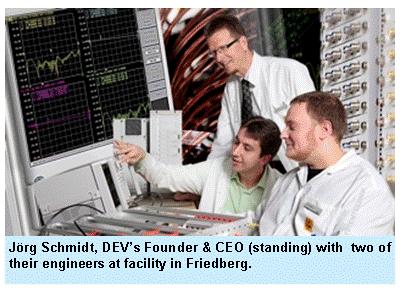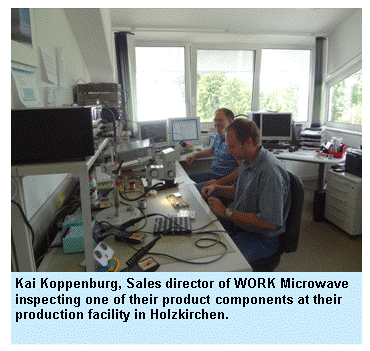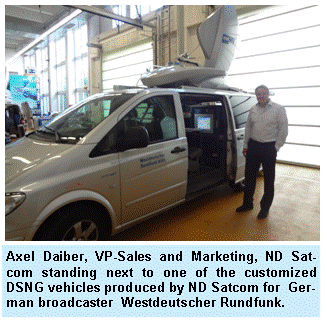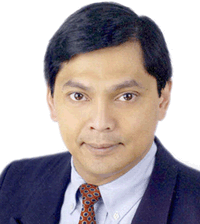The German Satellite Market
by Virgil Labrador, Editor-in-Chief
Los Angeles, Calif., December 6, 2012--Germany has one of the world's most technologically advanced telecommunications systems and is the largest telecom market in Europe. Because of intensive capital expenditures since reunification in 1990, the formerly backward system of the eastern part of the country, dating back to World War II, has been modernized and integrated with that of the western part.
Germany’s telecom sector has also been affected by the European debt crisis, prompting the government to step in with a US$64.94 billion (€50 billion) economic stimulus package, which included US$22.47 billion (€17.3 billion) of investment in infrastructure, of which a proportion is dedicated to telecom network upgrades. More than half of telecoms investment since the market was fully liberalized in 1998 has been undertaken by new entrants, which have steadily increased their expenditure since 2004.
Despite positive trends, turnover has fallen steadily since 2005, reaching an estimated US$75.98 billion (€58.5 billion) in 2011 as operators feel the effects of lower prices in fixed and mobile telephony as well as a number of regulatory measures designed to reduce costs for end users and encourage market competition. Revenue to 2013 is expected to be affected by these influences, but operators should subsequently expect an improving landscape as upgraded networks enable customers to take advantage of a greater range of bundled offer and higher ARPU mobile data services.
Germany's competitive television market is the largest in Europe, with some 34 million TV households. According to the results of the latest TV Monitor study, for the first time in the history of television in Germany, more viewers are watching TV via satellite than via cable. At the end of 2011, 17.5 million households were watching TV via satellite, almost 900,000 more than in the previous year. Ninety percent of these households were digital, leaving 1.8 million households still in the analogue reception mode. Out of the total, 5.9 million of all satellite households were watching High Definition (HD) TV. At the same time, cable lost about 900,000 households in 2011 and reducing the reach of cable TV to 17.3 million. Digital terrestrial TV lost 180,000 households, bringing its coverage down to 1.8 million. IPTV has continued to grow; with an increase of 330,000 households. In 2011, IPTV exceeded the million mark, reaching 1.3 million.
German’s broadcast media is a mixture of publicly-operated and privately-owned TV and radio stations; national and regional public broadcasters compete with nearly 400 privately-owned national and regional TV stations; more than 90% of households have cable or satellite TV; hundreds of radio stations broadcasting including multiple national radio networks, regional radio networks, and a large number of local radio stations.
The many regional and national public broadcasters — organised in line with the federal political structure — vie for audiences with powerful commercial operators. Each of the 16 regions regulates its own private and public broadcasting.
In April 2012, Germany terminated analog satellite TV broadcasts. As a result, satellite TV services continued to increase its reach in Germany after the analog switch-off, gaining customers in 100,000 households in the first half of 2012 to reach 17.6 million, Satellite Monitor Report said in its Sept. 4 report.
While German satellite broadcasting platforms enjoyed healthy growth, the country’s cable TV reception rates continued to decline from 17.3 million households in December 2011 to 17 million households in the first half of 2012. By contrast, digital terrestrial TV (DVB-T) seemed to benefit from Germany’s analog switch-off, reaching 2 million households by June 30 – a modest bump from the 1.8 million households reported in December 2011. Domestic Internet Protocol television (IPTV) service providers increased their reach to serve 1.4 million households by 2012’s halfway mark, compared to 1.3 million in December 2011.
German Satellite Companies
Germany has a thriving satellite sector with companies engaged in every key segment of the satellite industry from satellite manufacturing, ground equipment, satellite service providers and teleports.
The International Satellite Directory lists over 200 satellite services providers and equipment manufacturers companies based in Germany. This does not include hundreds of broadcasting companies and content production companies. So I apologize in advance if we did not mention or cover all the companies in the industry. The following are companies that I had the chance to visit during an eight-day trip to Germany in September.
Teleports
Germany’s central location in Europe makes it ideal for teleports to provide services throughout Western and Eastern Europe and even to the Middle East and Africa.
One such teleport is CET Teleport, located in a former Deutshche Telekom facility in Aarzen near the city of Hannover in northwest Germany. Its location gives it a commanding view of the skies with visibility from the Eastern Pacific, West Coast USA, South America, then covering Europe and Africa, all the way across Russia and China, and all of Asia, down to Australia.
CET Teleport is host to over 50 antennas from 15m downwards operating in C-, Ku,- Ka-, K- and X-bands and is fully integrated into Deutsche Telekom’s German fibre network, providing it with access to the terrestrial network for Internet connectivity and data and voice backhaul.
The CET teleport has a potential of accessing over 200 geostationary satellites located from 58°W to 76.5°E, providing coverage and connectivity across most of the visible globe.
Teleports dot the entire German landscape. Teleport operators include CeTel, NYNEX, Media Broadcast, Signalhorn Trusted Networks, Talia, MTI Teleport, IABG among others.
Hilkom Digital
Not far from CET Teleport is Hilkom Digital located in Bad Salzdetfurth. You wouldn’t expect a massive technical facility in this primarily rural area but Hilkom is located in the TecCenter where many hi-tech companies are located. Hilkom manufactures multi-format receivers and digital video processing equipment for the cable, IPTV and satellite industries.
Hilkom was formerly known as Blankom but changed its name this year to differentiate it from its sister company Blankom Antennentechnik located in Bad Blankenberg which manufactures digital encoders and headend equipment.
Narda Test Solutions
Located in Pfullingen near the city of Suttgart , Narda Test Solutions which manufacturers specialized RF test equipment for interference measurements: IDA (Interference and Direction Analyzer) and NRA (Narda Remote Spectrum Analyzer).
Considered as a high end provider of spectrum analyzers, Narda Test Solutiosns ‘s NRA-2500 analyzer is optimized for use in D-SNG, teleports and VSAT stations while its NRA –3000 is optimized for use in broadcast facilities and transmitter stations.
DEV Systemtechnik
Located near Frankfurt, DEV Systemtechnik offers a complete range of leading-edge, high-performance products and systems for the optical and electrical transmission of RF signals via coaxial cable or fiber for satellite, cable, and broadcast television head ends.
DEV products include: distribution amplifiers; splitters and combiners; switching systems; distributing matrices; routing products; multiplexersand fiber-optic RF signal transmission systems.
Work Microwave
 Near Munich, I visited the headquarters and main production facility of WORK Microwave located in the town of Holzkirchen in the foothills of the Bavarian Alps.
Near Munich, I visited the headquarters and main production facility of WORK Microwave located in the town of Holzkirchen in the foothills of the Bavarian Alps.
With more than 25 years of global expertise designing satellite communications technologies for the broadcast, satellite, and telco markets, WORK Microwave applies an innovative and creative approach to the development of frequency converters, DVB-S2 equipment and other digital signal processing technologies.
During my visit I was treated to a demo of the company's DVB-S2 IP-Modem SK-IP and saw the latest addition to WORK Microwave's modem range, the new DVB-S2 Modem SK-DV Combined Data and Video Modem, two cutting-edge solutions that maximize an operator's bandwidth while simultaneously lowering costs.
Astrium
 Astrium is Europe’s largest space company and is part of the EADS Group a consortium owned by French, German, British, Spanish, Dutch and other interests. In the Bodensee region near the Swiss border Astrium has a large campus which includes their satellite manufacturing facility and its subsidiary ND Satcom, a system integrator for satellite-based communication networks and a manufacturer of Radio Frequency (RF) equipment.
Astrium is Europe’s largest space company and is part of the EADS Group a consortium owned by French, German, British, Spanish, Dutch and other interests. In the Bodensee region near the Swiss border Astrium has a large campus which includes their satellite manufacturing facility and its subsidiary ND Satcom, a system integrator for satellite-based communication networks and a manufacturer of Radio Frequency (RF) equipment.
ND Satcom just won a “Best of IBC 2012” award for its XRACER DSNG system when I visited them. The XRACER DSNG system allows dual transmissions through live video uplinks on the move, and has a SKYRAY Compact antenna for static set ups.
Based on the VW Amarok platform, the XRACER vehicle features a small, stylish and cost-efficient DSNG system where both video data and location coordinates can be transmitted on-the-move, during speeds of up to 120 km/h. After reaching the destination of interest the SKYRAY compact antenna system is immediately available, using automatic pointing, for high quality transmissions of the broadcasting content. At the push of one button all system parameters are up and running, saving valuable time when news happens. The ND SatCom App allows the crew to operate the XRACER via smart phone.
Using ND SatCom's Media Fleet Manager, the vehicle's transmission capabilities can be remotely controlled from the network hub station, to let the crew concentrate on getting the story. The Media Fleet Manager is an easy-to-use management tool to plan, schedule and book DVB and IP uplink sessions via fixed and mobile stations. The vehicle also comes with built-in editing station and redundant power systems
Satservice
Last but not least, about 60 kilometers from the ND Satcom in Steisslingen is SatService GmbH, founded in 1996 by Michael Ulbricht, a former engineer at Nortel Dasa (ND Satcom’s predecessor). Satservice’s main focus is the development of customized projects for turnkey solutions as well as for satcom equipment.
Satservice provides the versatile sat-nms Network Management System, among other products. The sat-nms is a comprehensive software-based system providing monitoring and control of Single channel per carrier (SCPC)/ Multiple channels per carrier (MCPC) VSAT stations and in general satellite ground stations from a central site. The system consists of two parts: Network Management System (NMS) and the VSAT Local Controller (VLC) .
During my visit, I was given a preview of their latest product the sat-nms MANTN18/24 antennai—a fully electrical motorized 1.8m Antenna or a 2.4m Antenna. The antenna can be electrical positioned in elevation and azimuth as well as in the polarization axis. The system can be used as a simple positioner or with a software upgrade in step-track mode to track inclined orbit satellites. The customer operator interface is via web browser, HTTP protocol via TCP/IP or serial interface with an ASCII protocol.
General Observations
In all the facilities I visited, all the research and development (R&D) and production is done in-house. If anything is outsourced, it is usually done with another company also based in Germany. This gives German companies a unique quality advantage as well as streamlines the production process so that they can have speedier response times to meet customer requirements.
I also noticed a common sense of pride in their workmanship among the management and workers in the production facilities. Attention to detail is the norm there is a premium on craftmanship. For example at ND Satcom’s facility, the engineer giving the tour not only highlighted the technical features of their custom-made DSNG equipment, but took pride in showing the painstaking detail put in installing the upholstery car. The exemplify term “sticking to the knitting.”
In sum, german satellite manufacturing has maintained its leading edge position in the industry while keeping well-paid jobs in their country and investing heavily in R&D. There is also a spirit of entrepreneurship which encourages start-ups like DEV Systemtechnik and Satservice.
Finally, german companies thrive by developing new markets for their products, selling their products in markets all over the world. They have no qualms in expanding into new markets in Asia, Africa and Latin America and have been very successful in those emerging markets.
------------------------------------------
 Virgil Labrador is the Editor-in-Chief of Satellite Market and Research based in Los Angeles, California. He is the author of two books on the satellite industry and has been covering the industry for various publications since 1998. Before that he worked in various capacities in the industry, including a stint as marketing director for the Asia Broadcast Center, a full-service teleport based in Singapore. He can be reached at virgil@satellitemarkets.com
Virgil Labrador is the Editor-in-Chief of Satellite Market and Research based in Los Angeles, California. He is the author of two books on the satellite industry and has been covering the industry for various publications since 1998. Before that he worked in various capacities in the industry, including a stint as marketing director for the Asia Broadcast Center, a full-service teleport based in Singapore. He can be reached at virgil@satellitemarkets.com






